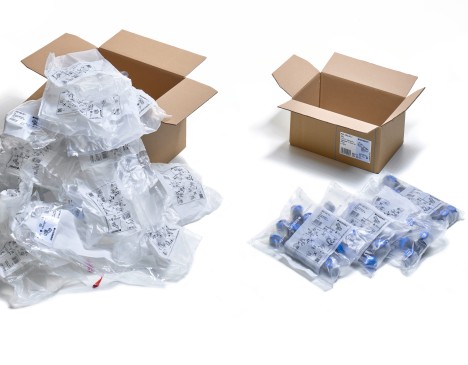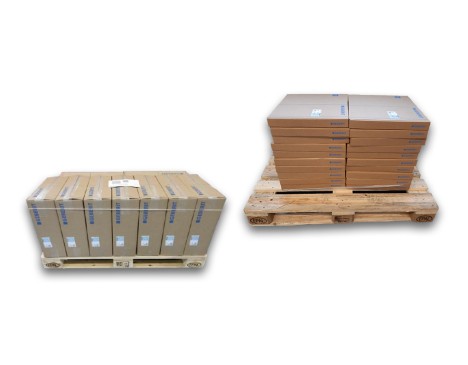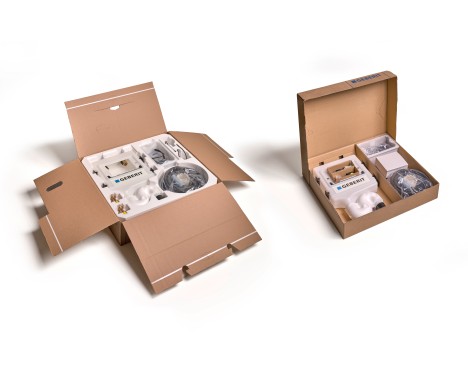Compactly packed
Saving resources with small adjustments
Less waste, less transport volume, fewer CO₂ emissions: For the benefit of the environment and to the delight of customers, Geberit is conserving valuable resources with optimised packaging. Three examples.
They pile up first in the factory, then in the forwarder's delivery van and finally in front of the house entrances. Yet they themselves are not objects of desire, but their contents. We are talking about packaging, which is experiencing a heyday thanks to online trading.
Geberit products are also well packaged so that they arrive safely at their destination. The feedback from customers, service experts and product developers always includes valuable ideas and solutions that lead to more environmentally friendly products. This also applies to their packaging. Three current examples:
Masterfix fittings: eight football pitches less foil
Since the assembly instructions can be lasered onto the protective cap of the Masterfix fittings as a QR code, there is no longer any need for packaging for each individual fitting. “Inconspicuously small, the QR code has a great effect,“ says Martin Granzotto, Project Manager Industrial Engineering at the Geberit site in Rapperswil-Jona, about the improvement. It is not to be sneezed at: Geberit saves 58,000 m2 of plastic film per year. A whole eight football fields could be covered with this amount of film. In addition, 1.8 tonnes less cardboard are needed. Together with the paper saved for the adhesive labels, which until recently were stuck onto the plastic bags, this material reduction lowers CO₂ emissions by 24 tonnes per year.

AquaClean toilet seats and lids: 20 km less adhesive tape per year
AquaClean spare parts arrive at the customer's in packaging that now resembles pizza boxes. Large, medium and small are the individual packages in which toilet seats and lids are packed. Not long ago, they were all delivered in an oversized standard carton with plenty of space and air, regardless of their size and space requirements. The benefits of the change are obvious: 60% less volume per package, 13 tonnes less cardboard and 20 kilometres less tape per year, which reduces CO₂ emissions by 12 tonnes. To compensate for these emissions, about 1,000 trees would have to be planted each year.

Sanitary flush: 250,000 fewer transport kilometres per year
Sanitary flush is becoming increasingly popular. It automatically flushes the pipes at regular intervals and thus prevents germs and bacteria from multiplying in drinking water pipes. Since 2021, the sanitary flush comes to customers in a small cardboard box, without the previous Styrofoam insert. Styrofoam is considered problematic because it is not biodegradable and difficult to recycle. Doing without this material is therefore a benefit for the environment. The new packaging also scores with other advantages: 40% less material is now needed. The packaging volume per unit has been reduced by 35%. This means that more boxes now fit on one truck. This means that about 250,000 fewer transport kilometres have to be driven per year. What do these figures mean for the environment? 33 tonnes less CO₂ in the atmosphere per year.

